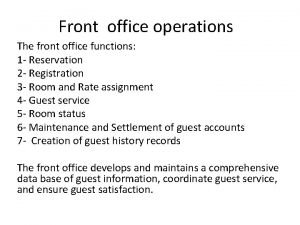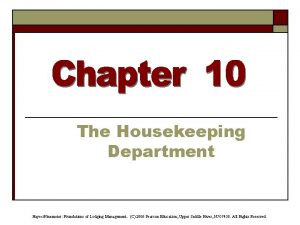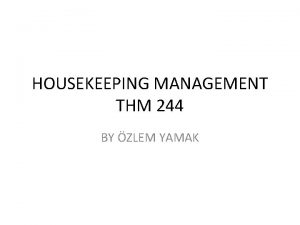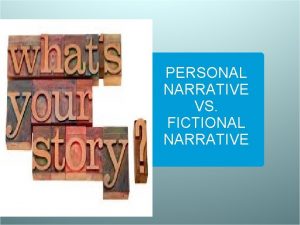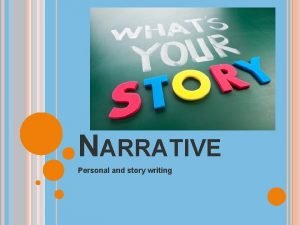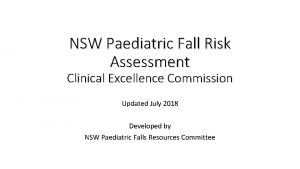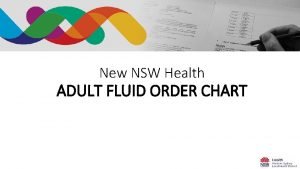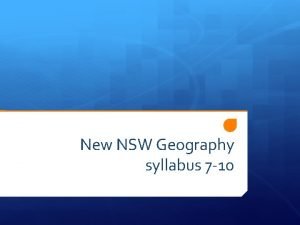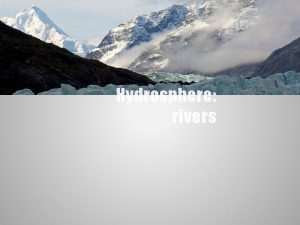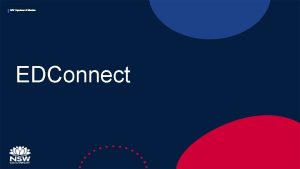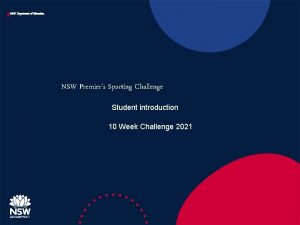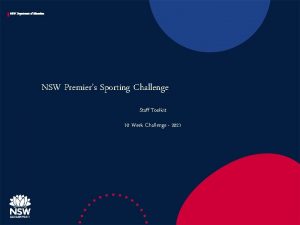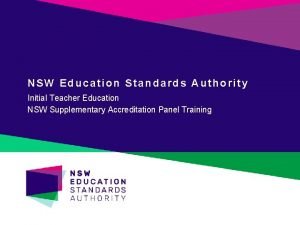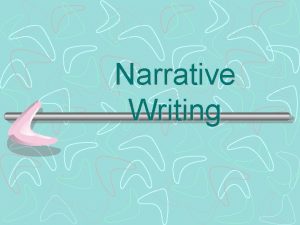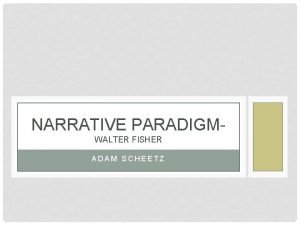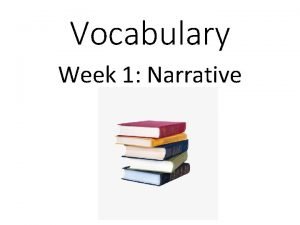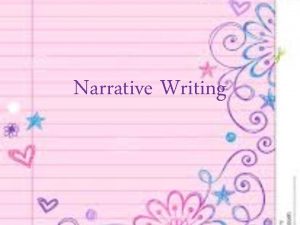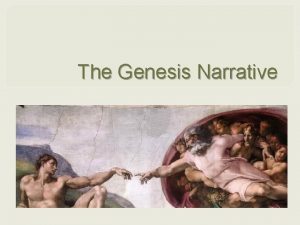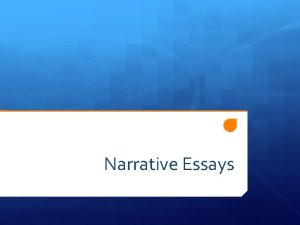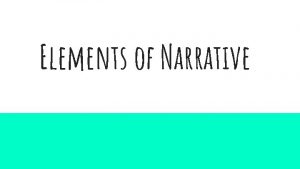NSW Department of Education Role of narrative in

















- Slides: 17

NSW Department of Education Role of narrative in the creative arts Stage 2 - Student activity resources – digital

NSW Department of Education Activity 1 Student resources

NSW Department of Education Learn a song Learn to sing 'Bring me down some of that rain' If you or your family are particularly effected by drought you may wish to talk to them about whether this song might upset you. 1. Learn to sing the song ‘Bring me down some of that rain' from Vocal Ease MORE (Module 2). 2. Use this animated score as a guide. 3. Pause and play to assist you to learn the song. The lyrics are also included on the next slide. 4. Practice keeping the beat and singing with the animated score and following the moving score. 3

NSW Department of Education Sing a song Learn to sing 'Bring me down some of that rain' (supporting lyrics) 'Bring me down some of that rain' By Tracy and Paul Burjan Vocal solo Verse 1 Oooo, ooo. It’s been dry so long, dust fills the air. Violin solo Cattle moving slowly past the creek bed, Verse 4 Promise water every year. I’ve worked this land so long, Verse 2 40 years or more. But the rains don’t come, Seems I’ve given it my life, my blood, my sweat They forgot to come. And all what for? And it’s hard out here, wondering will it ever end, Verse 5 Does this drought mean we’re all but done. Well it’s been good to me, Chorus I won’t complain. Rain oh rain, give me life end the pain. But please oh please, Let my creeks flow again. send me down some of that rain. Blow the whistle on the train as it passes once again, Chorus ‘cause the rain is here. Rain oh rain, give me life end the pain. Verse 3 Let my creeks flow again. The trucks pulled in, Blow the whistle on the train as it passes once again, To take my herd away. ‘Cause the rain is here (sing twice). And I’m wondering is it real, who would help me, could you help me, It’s here, ohhh, it’s here. Should I start to pray? 4

NSW Department of Education Think about folk songs Reflection questions • Think about how the song helped you to understand the composer’s story about living through drought. This is a type of folk song. Folk songs are songs that often tell a story. • What features of the music let you know that it is an Australian song? • What tells you it is a folk song? (the storyline, the instruments and the overall sound). 5

NSW Department of Education Think about the instruments Listening and reflection questions • Use these instrument guides to explore the instrumental tone colours (timbres) of the featured instruments: the violin and the tin whistle. Think of three adjectives to describe the sound of each of the instruments below. Write these down and add to the class online digital platform. • How do the instruments reinforce the meaning of the narrative? (For example, the sound of the tin whistle) • Violin • Tin whistle 6

NSW Department of Education Think about folk songs and narrative Reflection questions 7 • What other folk songs do you or your household members know? • Folksongs are a universal way of telling stories and there are examples in many cultures. • What story did they tell? • How does the music contribute to this story telling?

NSW Department of Education Activity 2 Student resources

NSW Department of Education Make an artwork Explore Australian identity through art There are many artworks that have become part of our Australian folk history and identity. Many examples are of the colonial history of Australia and the bush. Often artworks attempted to build a national identity and often a love (or sometimes disdain) for country. Examples include: • ‘Launceston and the river Tamar’ by John Glover (c. 1832) • ‘Rainy day’ by Charles Conder (1888) • ‘Beach scene’ by Arthur Streeton (1890) • ‘A token of friendship’ by Arthur Collingridge (1890) • ‘The Golden Fleece’ by Tom Roberts (1894) • 'On the wallaby track’ by Frederick Mc. Cubbin (1896) • ‘Reinforcements: troops marching’ by Grace Cossington-Smith (c. 1917) • ‘Bonfire in the bush’ by Grace Cossington Smith (c. 1937) • ‘Sunday evening’ by Russell Drysdale (1941) t • ‘The wasteland II’ by Jeffrey Smart (1945) • ‘First-class marksman’ by Sidney Nolan (1946) There are many more examples available through the Art Gallery of NSW’s Collection website that share narratives of Australian identity 9 both colonial, more recent and of course in Aboriginal art.

NSW Department of Education Write about it and share Describe the narrative of some artworks and share it with the class • Select 2 -3 of the artworks you found the most interesting. • Write the name and date of the work, the artist and what narrative (or story) you believe is being told through the artwork in the class digital platform. Comment on these aspects of the artwork: − Think critically about the artwork and describe the details that portray a narrative. − Reflect on the artist's use of colours, the implied textures, the use of the space such as the foreground, the background and the perspective. In some cases it is almost as though you can smell the landscape. How has the artist achieved this? − Do you think the artist is portraying a positive or negative opinion of life in Australia? 10

NSW Department of Education Write about it and share Describe the narrative of some artworks and share it with the class • Reflect on the way in which the narratives in these artworks relate to the folk songs learnt previously. Are there conflicting views of colonial Australia? What common relationship is there between the visual artworks and the musical compositions? • Ask any adult household members if there any artworks that were important in shaping their identify or of their culture when they were growing up? 11

NSW Department of Education Create and photograph Create an artwork that tells your story • Create an artwork that reflects your narrative, story or identity. You may use whatever materials you have available. You may choose to paint, draw or sculpt for example. • Consider your surroundings, the people that are important in your story or identity. • Where will the artwork to be set? For example, you may wish to set the artwork at the beach, in the bush, on a farm, in an apartment or on a suburban street. • Photograph your completed artwork and upload to the class digital platform along with your artist intent statement. This should indicate what the intention of the work is and the narrative behind it. 12

NSW Department of Education Activity 3 Student resources

NSW Department of Education Watch an animation Watch and interpret 'The fantastic flying books of Mr Morris Lessmore' • Watch the short, animated film ‘The Fantastic Flying Books of Mr Morris Lessmore’. • What is the film about? Ask a question in the class digital platform for other students about the film’s content or narrative and what they thought about the film. • In a comfortable place, pose as either Mr Lessmore, the lady, Humpty Dumpty or the girl. Take a photo (either a selfie or taken by someone else) to upload to the digital platform. Label the character being portrayed. 14

NSW Department of Education Act it out Do some drama miming • Make the shape of an object from the film such as the flying book, the globe, the bookshelf or the chair. Again, take a photo (either a selfie or taken by someone else) to upload to the digital platform. Label the object being portrayed. • Ideally with another person from the household, use mime and sculpt each other into position to represent a moment from the film. For example, the woman flying with the book bouquet, Humpty Dumpty introducing himself, Mr Lessmore giving a book away. Let’s sculpt – Spice it up video(2: 35 minutes) may assist you in understanding how to do this. 15

NSW Department of Education Act it out Do some more acting • Create a ‘postcard’ from the story. This should be around one of the most important moments in the film. For example, the flying books following Mr Lessmore, Mr Lessmore giving books out to people, or Mr Lessmore or the woman floating away with the balloon bouquet and so on. • Ideally do this with some other members of the household using this supporting video to assist. • If your household members are not available, create a 'postcard' on your own or draw a postcard from the story. • Again, take a photo (either a selfie or taken by someone else) to upload to the digital platform. Label the scene being portrayed in this ‘postcard’. 16 • Who would you send your 'postcard' to? • Reflect on what further this drama work has helped you understand more about the story.

NSW Department of Education
 Acecqa self assessment tool
Acecqa self assessment tool Department of primary industries and mines
Department of primary industries and mines Nsw education
Nsw education Front office operations
Front office operations The generic term for the guest room sheets and pillowcases
The generic term for the guest room sheets and pillowcases Housekeeping productivity formula
Housekeeping productivity formula Azure web role vs worker role
Azure web role vs worker role Interaktionistisches rollenmodell
Interaktionistisches rollenmodell Statuses and their related roles determine the structure
Statuses and their related roles determine the structure Fictional narrative writing
Fictional narrative writing Personal narrative vs fictional narrative
Personal narrative vs fictional narrative Public service talent pool
Public service talent pool Falls risk assessment tool nsw
Falls risk assessment tool nsw Nsw energy savings scheme
Nsw energy savings scheme Fluid chart nsw health
Fluid chart nsw health Nsw geography syllabus
Nsw geography syllabus River systems nsw
River systems nsw Employee value proposition australia
Employee value proposition australia



